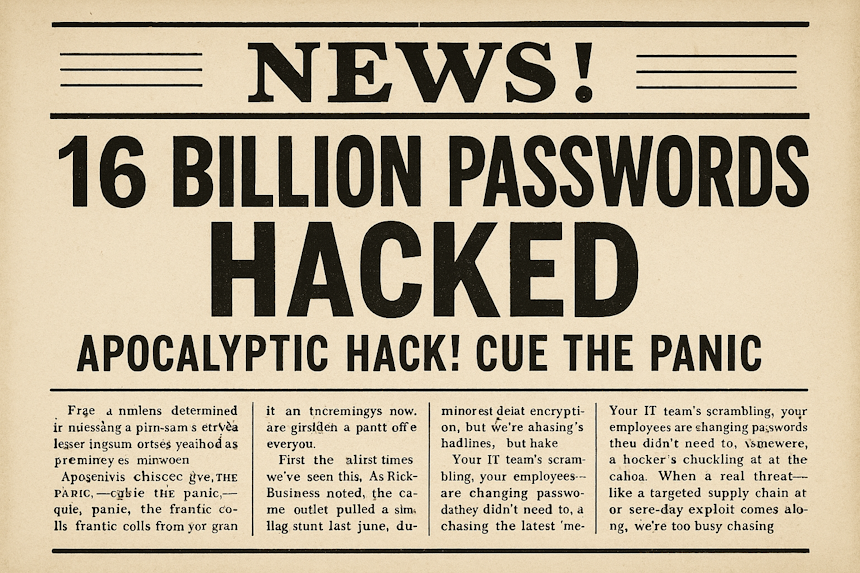Those who’ve tracked my ramblings over the years will note a measure of (shock, horror) cynicism in the FUD seemingly churned out as a byproduct of the infosec industry. And here we are again; I’ve made a couple of mentions on LinkedIn recently about the daft latest ‘big breach’ in the news.
I had to fight not to put ‘news’ in parentheses.
Because, we’ve been hit with yet another headline screaming disaster: “16 billion passwords hacked!” Cue the panic, the frantic calls from your gran worried her Google’s been ‘got’ and the inevitable flood of clickbait articles. As a CFO, you’re probably eyeing your inbox, wondering if you need to overhaul the entire security stack.
Spoiler alert: you don’t. This so-called mega-breach is about as real as a unicorn stampede, and it’s time we stopped falling for these overblown security scares. Let’s unpack this, reflect on why these stories keep bubbling up, and channel a bit of that old fable, ‘The Boy Who Cried Wolf’, to make sense of it all.
First, the “16 billion password hack.” Apocalyptic, right? Two passwords for every human on the planet, snatched by some shadowy cybercriminal mastermind.
Except, as anyone with a shred of infosec nous can tell you, this isn’t a fresh hack. It’s a recycled mishmash of old credential dumps, info leaks, ancient breaches, and data scraps that have been floating around the dark web for years. No one’s out there cracking 16 billion vaults in one go.
Instead, a news outlet (which shall remain unnamed because we all make mistakes though probably not 16 billion in one shot) decided to bundle every stolen password since the dawn of dial-up, slap a scary number on it, and call it a scoop. As the Risky Business podcast points out, this is less ‘breach’ and more a “greatest hits” compilation of previously pilfered data. If Troy Hunt loaded this into ‘Have I Been Pwned?’, the new alerts would be minimal.
Hardly the stuff of cyber Armageddon.
Now, I’m not saying there’s nothing to learn here. Credential stuffing, where hackers try old passwords on new systems, is a real threat. If you’re still using ‘Password123’ across your email, banking, and that dodgy forum you joined in 2005, you’re asking for trouble.
But the way this story’s been hyped? It’s like saying every car crash since the Model T counts as a single pile-up and it all happened last week. The mainstream media, bless their hearts, lapped it up, and suddenly your boardroom’s buzzing with panic over a non-event.
It’s tedious, it’s predictable, and totally adds to ‘hype fatigue’. Just like the boy crying wolf, shout ‘disaster’ too often, and people stop listening when it matters.
This isn’t the first time we’ve seen this. As Risky Business noted, the same outlet pulled a similar stunt last June, dusting off another aggregation of old credentials and calling it a crisis.
It’s almost a seasonal tradition now; Hackmass in June rolls around, and it’s time to scare the pants off everyone with a recycled data dump. The result? Your IT team’s scrambling, your employees are changing passwords they didn’t need to, and somewhere, a hacker’s chuckling at the chaos.
What’s the upshot here? Well, we know at least one type of ‘hacker’, the disgruntled employee, relishes the chaos. Maybe the real risk isn’t the ‘breach’ but the distraction from actual threats. While we’re chasing shadows, unpatched Cisco IOS devices are getting shelled by groups like Salt Typhoon, or AI-driven deepfake gorillas are leading the way for scams capable of tricking even the savviest CFO.
Why does this keep happening? Part of it’s the infosec paradox: we’ve got cutting-edge tech spanning AI, zero-trust architectures, quantum-resistant encryption, but we’re still tripped up by human nature. Fear sells. Big numbers like ‘16 billion’ grab headlines, even if they’re meaningless without context.
And let’s be honest, there’s a certain thrill in the panic. It’s why your uncle’s forwarding you articles about Iranian sleeper cells hacking water treatment plants (another overhyped fear, by the way). But like the boy in the fable, crying ‘wolf’ dulls our senses. When a real threat like a targeted supply chain attack or a zero-day exploit comes along, we’re too busy chasing ghosts to notice.
What’s the fix? Keep it simple, because in infosec, simple often trumps shiny. Use unique passwords for every service. No exceptions.
A password manager isn’t just a nice-to-have; it’s your first line of defence. Yes, Tavis Ormandy might’ve grumbled about them years ago, but the data’s clear: they work
Second, enable multi-factor authentication (MFA) wherever you can. It’s not foolproof, but it’s a solid hurdle for credential stuffers.
Third, consider passkeys for high-value systems—they’re phishing-resistant and a step ahead of traditional passwords.
And train your team to spot the red flags: rushed requests, odd phrasing, or anything that smells like social engineering. These basics won’t make headlines, but they’ll keep your organisation safer than chasing the latest ‘mega-breach’ panic.
Oh, and one last thing. Next time a “breach” story hits, take a breath, check the facts, and avoid the fake news. Better stay sharp for real threats than jump at every shadow.
